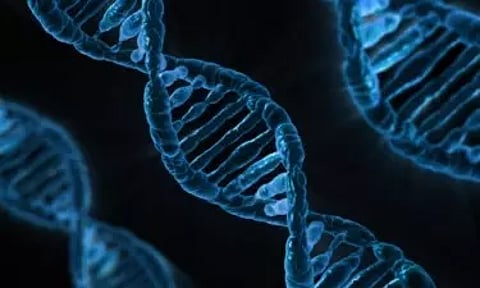

NEW DELHI: A new technique that uses whole genome sequencing can help personalise drug therapy in tuberculosis (TB) patients and ensure complete treatment for the disease, according to a biotechnologist.
Anirvan Chatterjee, founder & CEO of HaystackAnalytics, a start-up incubated at the Indian Institute of Technology (IIT) Bombay, noted that the method provides a means for conclusively ascertaining drug resistance in a TB patient.
Complete treatment of TB patients is significant as being a transmissible disease, TB presents the risk of spreading and evolving into a superior drug-resistant version of itself.
Caused by the bacteria Mycobacterium tuberculosis (MTB), TB is an infectious disease that spreads through the air when people with lung TB cough, sneeze, or spit. The symptoms include prolonged cough, chest pain, weakness or fatigue, and fever.
''Currently every TB patient undergoes a Nucleic Acid Amplification Test (NAAT) as the primary screening for confirmation of TB and detection of resistance to 1 or few drugs. If found resistant, the patient is advised more tests to get the complete drug-resistance profile,'' Chatterjee told PTI in an interview.
NAAT is a molecular test that detects the DNA of the TB-causing bacteria in a patient's sputum or other respiratory sample.
Leveraging whole genome sequencing (WGS), a method for analysing entire genomes, on a TB positive patient's sample can eliminate this need for multiple tests and provide a comprehensive drug resistance profile against all the drugs currently prescribed by the World Health Organization (WHO), according to Chatterjee.
''In case a WGS report is available for a TB patient, the therapy can be fully personalised while adhering to the drug combinations determined by the WHO,'' he said.
The WGS testing process involves sequencing the entire DNA of the TB-causing bacteria in the patient's sample. Then, by analysing data from about 4.5 million data points on the genome using bioinformatics and machine learning technologies, the resistance of the bacteria to any of the 18 antibiotics is ascertained in under two weeks once the sample has reached the lab.
''For the report, we analyse the (bacterial) strain type, depth of sequencing, coverage of the genome, drug resistance mutations which have been validated to be associated with in-vitro resistance, phylogenetic association with global strains,'' said Chatterjee, who was a postdoctoral researcher at the University of Oxford, UK, when he developed this technology.
He, along with colleagues from many international institutes, has published multiple research papers where TB-positive samples from patients in Mumbai, Oxford, and Birmingham, UK, were analysed for drug resistance to first- and second-line anti-TB drugs.
''First-line tuberculosis (TB) treatment includes four drugs (rifampin, isoniazid, ethambutol, and pyrazinamide), but with the spread of multidrug-resistant strains, there is a growing need for data on second-line drugs, including the fluoroquinolones and aminoglycosides,'' the researchers wrote in their study published in the Journal of Clinical Microbiology.
The incomplete drug resistance profile adjudged in a microbial culture test together with long waiting times for results not only enhances the risk of the spread of TB, but also the risk of it becoming more drug-resistant, according to Chatterjee.
According to the National Anti-TB Drug Resistance Survey (NDRS) 2014-16, Multi-Drug Resistant TB (MDR-TB) was 6.19 per cent of all TB patients, or about 9.1/lakh population.
''For every untreated or incorrectly treated TB case, there are 2.3 new potential TB patients. Mathematically, this amounts to the possibility of replacing a treatable disease with a very difficult-to-treat disease,'' said Chatterjee.
According to the WHO, multidrug-resistant TB (MDR-TB) remains a public health crisis and a health security threat, with only about 1 in 3 people with drug-resistant TB accessing treatment in 2021.
The National TB Elimination Programme (NTEP) in India lays down guidelines for clinicians around managing and treating drug-resistant TB patients in its document ''Guidelines for Programmatic Management of Drug-Resistant Tuberculosis in India”.
The NTEP advises, ''Genetic sequencing can be used when reliable Drug Susceptibility Test (DST) is not available”.
However, it also says that ''concerns regarding costs, integration into existing laboratory workflows, and technical training have hindered (the technology's) uptake”.
Chatterjee said his start-up HaystackAnalytics has received a BIRAC grant from the Department of Biotechnology (DBT) to make this technology available and accessible in India.
''We validated our technology and with that, we have been able to bring down the cost of the test significantly. Currently, the test is available in India at Rs. 6,450,” said Chatterjee, whose validation work is published in the Global Journal for Antimicrobial Resistance.
''Not only is the technology more superior, the turnaround time quicker, but also the (drug-resistance) information is much richer,'' said Chatterjee.
Having been operational for more than a year and a half, he said, HaystackAnalytics has partnered with pathological laboratories across the country to enable them to make this test available to doctors and, through them, to their patients.
''A typical pathological lab associated with HaystackAnalytics for providing WGS-based testing of TB samples would perform pre-sequencing processes such as sample collection, sample decontamination, microbial enrichment, and DNA extraction. Since TB drug resistance testing is performed in central processing laboratories, these labs are fully equipped to perform these steps,'' explained Chatterjee.
Chatterjee's eventual goal is for the WGS test to be included in the NTEP as, according to him, that is when ''this entire conversation around TB elimination by 2025 (in India) will start looking real.''